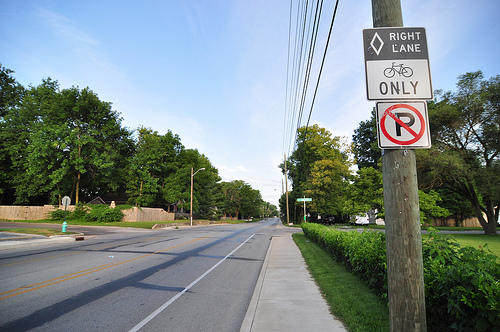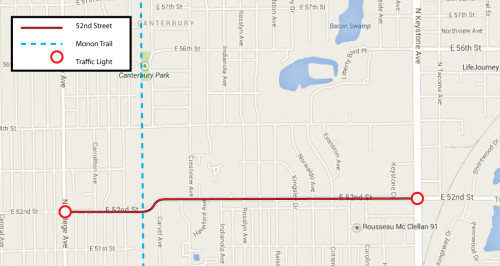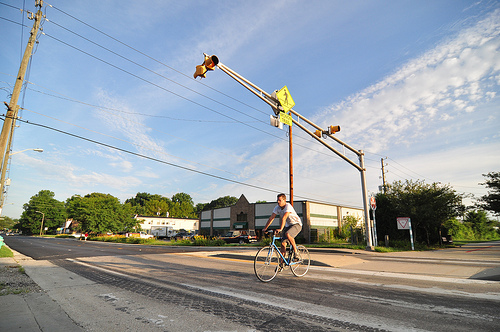When was the last time you set off in your own neighborhood, on foot or bike, to explore just how far you can get before it becomes a real chore to get where you really want to go? This task happens often in my household since we are a 3 member family with one car and the resulting choice of transportation often involves a bicycle.

I don’t often take time to write about the environment of the neighborhood in which I live, but a recent experience caused me to put my urbanist hat on to explore the root cause of a difficult street crossing. I was riding my wife’s bike with our tow behind trailer and 3 year old son riding co-pilot. The time of the day was roughly 6pm and I had a suspicion that getting where we wanted to go might involve some difficulty. Just how much we were going to encounter might have caused me to re-evaluate our route choice if I had to do this over again. Our destination was Canterbury Park, one of my son’s favorite playgrounds. We set off northbound on our journey and encountered 52nd street where we were forced to wait for nearly 5 minutes before we could cross to the west bound bike lane because of frequent and rapid automobile traffic.

We were not close enough to the Monon to use it as a gateway which would have been ideal. Furthermore, there are no additional signaled crossings or traffic lights for pedestrians along this stretch. When you think about 52nd street between Keystone & College, your first impression might not be that of danger and the need for caution. Indeed, this stretch used to be comprised of 4 lanes for cars before it was put on a lane diet and reduced to 1 lane in each direction, a center turn lane and curb bike lanes. This is a recipe I have supported in the past in strategizing how we decrease our city’s automobile lane miles with the goal of creating safer designs for cyclists & pedestrians.
However, while these improvements may have added a measure of safety, crossing the street, especially at rush hour, is still difficult for cyclists & pedestrians. Part of this difficulty lies with the fact that no additional physical traffic calming features were introduced with the lane diet. Features such as bulb-outs or pedestrian striping could have went a long way towards calming traffic speeds.  The speed limit is 35mph but I can attest first hand, that the cars feel like they move much faster than this when standing on the sidewalk attempting to cross. Furthermore, the only traffic lights on this stretch are located at Keystone Avenue and College Avenue, a distance of 1.3 miles, creating a long stretch for motorists to accelerate to and maintain high speeds. The only real features which might cause a motorist to instinctively slow down are a slight chicane just east of the Monon Trail, and the trail itself.

Bottom line, the design of the street is such that automobiles move freely east & west and pedestrians or cyclists attempting to move across have a tremendous barrier preventing them from safely crossing. In hindsight, simply removing auto travel lanes and adding bike lanes has done essentially nothing to encourage walking and leads to segregated neighborhoods as a result.
How does this design affect our neighborhood’s connectivity? One might simply conclude that the presence of bike lanes helps, but when crossing the street to use them proves to be as big a task as before, what good are they? Additionally, the lack of space between the sidewalk and roadway puts pedestrians very near the fast moving traffic. Who wants to attempt to move their children across this sort of landscape with the ever present threat of cars quickly zipping by?
While the simple fact is that our city lacks the money to properly modify this street to be the pedestrian-friendly arterial that it could be, something should be done with the design to encourage long term confidence in residents and perhaps create an environment that sheperd’s family growth in this part of town, something that is sorely lacking.
This problem isn’t unique to 52nd street. 46th street, a similarly designed street just blocks south, is encumbered with the same design. How could neighborhoods take action to increase safety along this stretch?
It is certainly an interesting issue. Our family loves to take walks, but we rarely cross College Avenue, so we stay on our side, or wherever we can get on the Monon. On foot or bike, we can access the Canterbury neighborhood easier than we can the rest of Meridian-Kessler.
Very observant post. I too stay on my side of College more often than not. And I try to use 46th to reinforce its walk/bike-ability, but it’s challenging. This might also explain why I often see people biking in the wrong direction on 46th and 52nd Street bike lanes; they’re scared (or it’s too much trouble) to cross to the correct side, another unintended consequence of little traffic calming. And then there are the telephone poles in the sidewalks… Every time I hear about the state’s budget surplus and Indiana being the envy of its neighbors, I shake my head. I know it’s another pot of money but still. Thanks!
At least you have sidewalks on major arterials. On the Southside we have drainage ditches on major streets. There is no connectivity between subdivisions. You would never want to take your child out for a bike ride or walk outside your own neighborhood. There is no other way to get to a park other via a car.
This is exactly how I felt. I’d kill to have this problem .
I rode last week through the south side to get to Trafalgar/Lamb Lake. I knew the south side lacked a good bike infrastructure, but I was shocked (and a bit scared for my safety) about how bad it actually is.
That day, I vowed to avoid the south side at all costs.
While I was in Chicago, we were hanging out around Lincoln Park (and numerous other places) and it appears that it is codified that cars must stop for pedestrians using a crosswalk. There were always yellow signs on the center stripe that said something like “Yield to pedestrians. It’s the law!” with some illustrations of a yield sign and a pedestrian.
I’m going to go out on a limb and say Indy doesn’t have this law. I cross Virginia just south of the CSX rail viaduct by Anthem and only about 1 in 10 cars stops for me. I’ve even been clearly partially in the street on the crosswalk and had cars swerve around me to avoid having to slow or stop for me. I’m going to start pressuring my city-county councilor to try to get it codified. Then I’ll just have to whine about the lack of enforcement.
I’m pretty surprised more people aren’t killed or injured at all the Monon crossings, but then again, maybe I just don’t hear about it.
It is my understanding Indianapolis has a traffic law that requires cars to stop and allow pedestrians the right of way at crosswalks, so why are there signs posted at every street intersection with the Monon that read, “Cross Traffic Does Not Stop”. Isn’t this a contradiction to the traffic laws?
I still think Monon users should be cautious when crossing, but many times, drivers seem to be confused about whether they should stop. If the City doesn’t enforce traffic laws at crosswalks along the Monon (a trail that attracts over a million users each year), i would guess it would be a long time before any thought is given to pedestrian improvements on 52nd street.
I’ve always believed that every cross street along the Monon should have either a stop sign or a stop light at the busier street (16th, 38th, BR Ave, and probably a few others). Give bicyclists and skaters one path where they don’t have to potentially stop at every intersection.
It drives me nuts watching all the Monon users sitting at the intersection waiting for all the cars that just cruise through the intersection after they pass under the flashing yellow lights. Technically, I don’t really know what the rule is here. The Monon is posted for trail users to stop, but yet I’m pretty sure the flashing yellow lights are meant to tell drivers to stop if trail users are present. I’m usually pretty aggressively about crossing the streets as a trail user as long as I feel confident that the drivers will see me in plenty of time to stop, but understandably, most trail users aren’t as apt to assert themselves into the intersection when vehicles are approaching, and so they sit and wait and thus many drivers just continue through since the trail users are patient.
Back on point, it does seem ridiculous to have streets in an urban area with 1.3 mile stretches with no stop lights or stop signs. One would expect that in suburbia where there are fewer arterial/collector streets, but not in a pre-WWII neighborhood (?) in a major metropolitan area. Unfortunately, there isn’t really any north-south street between College & Keystone that would be well suited to being a slightly higher traffic collector street that would then be a logical place for a light or stop sign. Nonetheless, I think that it would be appropriate to push for one or more signalized intersections or 4-way stops in these long stretches.
That’s a post WW-2 neighborhood east of the Monon. Early first-ring suburban, with only a few curving streets (look at an aerial).
My first house was in the Canterbury neighborhood pre-Monon Trail; unlike the Meridian Kessler and Forest Hills neighborhoods west of the Monon, Barrett Law assessments were not used to put sidewalks in on most streets east to Keystone.
(reposting due to HTML errors on my part)
IANAL, but did some Googling because I was curious as to what the law says, and found this: http://www.in.gov/legislative/ic/code/title9/ar21/ch17.html
“A pedestrian may not suddenly leave a curb or other place of safety and walk or run into the path of a vehicle that is so close as to constitute an immediate hazard.”
“Except as otherwise provided in this chapter, a pedestrian upon a roadway shall yield the right-of-way to all vehicles upon the roadway.””
Then there is: http://www.in.gov/legislative/ic/code/title9/ar21/ch8.html
“Except as provided in IC 9-21-17-8 and IC 9-21-3-7(b)(4)(C), when traffic control signals are not in place or not in operation, a person who drives a vehicle shall yield the right-of-way, slowing down or stopping if necessary to yield, to a pedestrian crossing the roadway within a crosswalk when the pedestrian is upon the half of the roadway upon which the vehicle is traveling or when the pedestrian is approaching closely from the opposite half of the roadway.”
It’s a little confusing to work out, so please someone correct me (seriously, I don’t have a dog in this fight) but my understanding is drivers are required to yield to pedestrians WITHIN the crosswalk/roadway, but not to folks just standing on the curb/approaching on the trail. Pedestrians darting out as to create a hazard are committing a “class C infraction”.
This is correct. If a pedestrian/bike is already crossing, one must yield to said pedestrian/bike.
However, cars still have the ROW otherwise, and pedestrians/bikes must yield to already-moving traffic.
I think it means that a pedestrian has the ROW to cross, even if a vehicle is approaching, as long as that vehicle has a reasonable amount of time to safely slow or stop to accommodate the crossing. Of course, peds aren’t allowed to jump in front of traffic that is almost at the crossing.
“Except as otherwise provided in this chapter, a pedestrian upon a roadway shall yield the right-of-way to all vehicles upon the roadway.â€
I think this just means that you’re not allowed to walk down the middle of the street impeding traffic.
If vehicles see a pedestrian/bicyclist waiting to cross, they should slow or stop to allow them to cross. However, it can sometimes be more dangerous if there are multiple lanes in the same direction and one lanes stops but the other(s) doesn’t.
Bottom line in my opinion is that we need more signals or stop signs on these streets. There could even just be a push button activated flashing red similar to what was recently installed on S. Delaware for Lilly employees.
Thanks for those citations.
I’m an aggressive walker and when the car has plenty of distance (like >100 feet), I’ll pretty much walk out in the street and expect them to stop. Like I said, many times they will simply do everything they can to avoid slowing or stopping (swerving, speeding up). Very irritating.
Typically I’m with my kids and don’t leave the curb till it is clear. This is where the 1 in 10 cars stops to let us cross comes from.
“In hindsight, simply removing auto travel lanes and adding bike lanes has done essentially nothing to encourage walking…”
This is one reason why “solutions” like this are often derided by the majority of the population. More thinking ahead of time might have allowed for mitigation of the problems you identified during the process that created the bike lanes. Traffic engineers often aren’t overly creative, so getting some creative thinkers into the process early on might prove beneficial.
It’s not just about infrastructure. For a walk to be favored, it has to be useful, safe, comfortable and interesting- http://www.urbancincy.com/2013/06/review-walkable-city-offers-clear-guidance-on-how-to-improve-cities/
There’s nothing wrong with the concept of neighborhood boundaries, man made or natural. Going back to the Neighborhood Unit concept, large streets have always been a man made boundary. A boundary road can be useful when it serves a commercial function and is permeable from bordering neighborhoods. Maybe all you can do here is a road diet if it’s not a commercial area and is viewed as a boundary between neighborhoods. See APA publication Neighborhood Boundaries from Dec 1960.
When I lived in the area, it was unclear if most folks viewed 54th or 52nd as the “neighborhood boundary”. The only organized/functioning NA in that area is Canterbury, which goes from 54th to Kessler, and is characterized by its streets running east-west like ladder rungs between Carvel and Crestview Avenues…contrary to the platted layout of the whole rest of the northside of Indy, where houses are mostly on north-south streets.
East of there was an area generally referred to as the “Christ the King” neighborhood; for a long time 54th was its natural south boundary because of the former Bacon Swamp.
So I’d say that 52nd isn’t necessarily a neighborhood boundary. But because it long served the industrial/commercial cluster along the Monon and Winthrop Ave. from 52nd to 54th, and runs through former gravel-pit lakes to Allisonville (the former SR37) it’s probably a necessary arterial. 49th and 54th end at Keystone.
As Curt points out, it’s busy serving all the north-south residential streets, and so traffic isn’t platooned…which makes it hard to cross on a heavy bike.
But I’m curious, Curt…with a CLTL, why not cross partway and use it as a refuge? Or is the bike-plus-trailer longer than the CLTL is wide?
Boundaries can be the arterials at the periphery of defined neighborhoods but also the collectors that bisect larger neighborhoods into subsets. 52nd seems more of a neighborhood collector between the local roads and arterials. In that case, I’d propose to eliminate all vehicular/bike striping and to add cross walks at every street to make it clear that it’s a pedestrian zone, not just a collector for cars/bikes.
Don’t have anything to contribute to this current conversation. However, I just saw an article on IBJ about the proposal for the new luxury apartment tower going to be built in the former area of Market Square Arena. http://www.ibj.com/81m-msa-plan-calls-for-28-story-tower/PARAMS/article/42467
Any thoughts or future articles on this development?
How many structured parking spaces $17 million builds.
As Chris sort of touched upon, the divisions somewhat define the neighborhoods. In older areas, sometime long gone dividers leave existing neighborhoods in their wake.
Also, because the n-s streets don’t perfectly align at 54th, I suspect that the land was developed between 52nd/54th and 54th/Kessler separately.
On the plus side, some efforts are being planned to improve “traffic calming” in that area. Curb bump outs, raised crosswalks, improved signage, etc.
http://mkna.blogs.marketpath.com/latest-news/meridian-kessler-long-range-traffic-calming-plan
I especially like the idea of raising cross-walks to serve as informal speed humps.